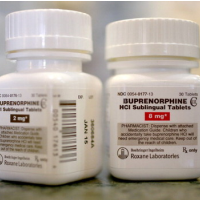Doctors Restricted From Prescribing Addiction Treatment
 Credit: Joe Raedle/Getty Images
Credit: Joe Raedle/Getty Images
By Austin Frakt, New York Times News Service
Almost 1 million U.S. physicians can write a prescription for opioid painkillers such as Vicodin and OxyContin — one pathway to opioid addiction. But, because of regulatory hurdles and other factors, fewer than 32,000 doctors are permitted to prescribe buprenorphine, a medication to treat such addiction.
That is a statistic worth thinking about since opioid painkillers and heroin contributed to the deaths of nearly 30,000 Americans in 2014, triple the number in 2000. Perhaps many of these lives could have been saved with buprenorphine. The Obama administration intends to increase access to it — and its proposed budget would commit hundreds of millions of dollars to do so — but it will not be easy.
Taking buprenorphine or methadone, alongside counseling, is the most effective approach to opioid addiction treatment. Because the drugs relieve patients’ cravings for heroin or narcotic painkillers, patients taking them can focus more on recovery and less on getting high. When taken properly, the drugs can help addicted patients and their families get their lives back to normal while reducing the risk of fatal overdose, crime and their societal costs.
But the need for these treatments far outstrips available supply. Less than half of the 2.5 million Americans who could benefit from medication-assisted treatment for opioid addiction receive it.
Expanding the use of methadone will be difficult. Methadone is provided only in dedicated clinics, which patients must visit daily. But many communities resist clinics because they attract patients with addictions, a highly stigmatized population.
Work by Christopher Jones, a pharmacist and public health researcher, showed that the number of patients treated at them has barely increased in more than a decade. Most methadone clinics operate at or near capacity, and some have waiting lists.
Expanding buprenorphine use could be simpler but is still fraught with challenges. Though used to treat opioid addiction, buprenorphine, like methadone, is an opioid-based medication, so it too can be abused if improperly used. However, it does have a lower overdose risk than methadone.
Since 2000, buprenorphine can be prescribed by qualified doctors to a limited number of patients to take at home. Buprenorphine use has expanded as a result, but availability is limited by regulation. Doctors may prescribe it only after taking an eight-hour course and applying for a special license. No such hurdles are required for prescribing any opioid painkillers.
Buprenorphine use got a boost in 2006 when another change in the law permitted physicians who have held the special license for at least a year to prescribe buprenorphine to as many as 100 patients at a time, up from 30. Because the drug can be misused or diverted for illicit sale, the limit is in place to prevent the emergence of buprenorphine “pill mills” — clinics that make a buck from high rates of prescription and with insufficient patient oversight.
A study led by Dr. Bradley Stein of the RAND Corp. found that this change increased access to treatment. But the regulated supply has not kept pace with the need. Jones’ study found that even if all doctors who are approved to prescribe buprenorphine did so to the maximum number of patients permitted by law, 1 million patients who could benefit from it would still be unable to obtain it.
Last fall, Sylvia Burwell, the Health and Human Services secretary, announced plans to remove regulatory obstacles to buprenorphine. The agency wants to increase the number of doctors who prescribe the drug and will also consider expanding the types of clinicians who are permitted to do so. HHS is also planning to revise the rules governing the number of patients to whom doctors can prescribe the drug, though precisely how has not been announced.
Now, the bad news. Many doctors are reluctant to prescribe buprenorphine; only 2.2% have met the regulatory requirements. Most of those limit the number of patients they treat below the maximum allowed by law, so increasing that maximum alone would probably have little to no effect.
Of 78 primary care physicians surveyed for one study published in 2014, 64% had obtained approval to prescribe buprenorphine, but only 28% did so. And half of those treated only three patients, well below the lawful maximum. Chief barriers to increased prescribing cited by these physicians were lack of confidence in managing addiction and insufficient mental health support in doing so.
“Increasing availability of medication-assisted treatment will require far more than just allowing doctors to prescribe buprenorphine to more patients,” Stein said. “Fostering greater ability and willingness among doctors to effectively manage the growing numbers of addicted patients is an uphill battle.”
To Learn More:
Another State Reports Uncontrolled Rise in Prescription Drug Abuse (by Noel Brinkerhoff, AllGov)
Americans Overwhelmingly Prefer Treatment to Prosecution for Illegal Drug Users; Alcohol Viewed as more Harmful than Marijuana (by Noel Brinkerhoff, AllGov)
- Top Stories
- Unusual News
- Where is the Money Going?
- Controversies
- U.S. and the World
- Appointments and Resignations
- Latest News
- Musk and Trump Fire Members of Congress
- Trump Calls for Violent Street Demonstrations Against Himself
- Trump Changes Name of Republican Party
- The 2024 Election By the Numbers
- Bashar al-Assad—The Fall of a Rabid AntiSemite






Comments